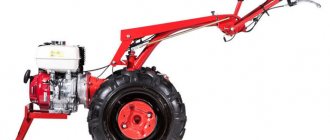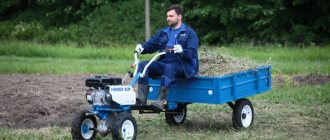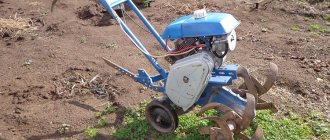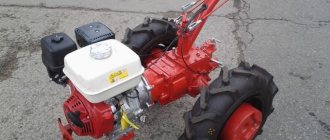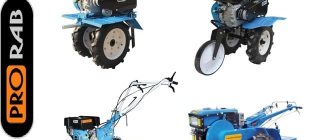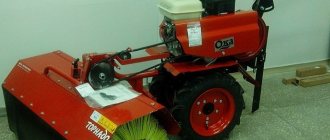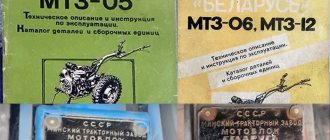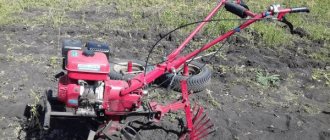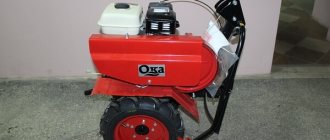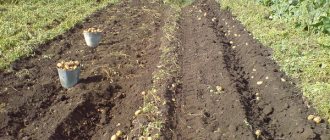Tractor attachment
Mounted and semi-mounted machines can be located at the rear, front, front, side of the tractor or in several places in separate sections.
Diagrams of various methods of mounting machines and implements on a tractor:
a - rear linkage; b - front; c - frontal; g - lateral; d - echeloned; e - rank; 1 - mounted machine; 2 - rear loosening paws for sealing wheel tracks
The rear linkage (Fig. a) is used to attach most tillage, sowing and planting machines to general-purpose and universal tractors.
The front linkage (Fig. b) is used on self-propelled chassis, in which row-crop cultivators and other machines are located on the frame in front of the drive wheels.
The front hitch (Fig. c) allows you to hang reapers, draggers and some other harvesting machines in front of the tractor.
Side hitches (Fig. d) are used on hay harvesting machines coupled with low-power tractors, and sectional ones (Fig. e and f) for medium and high power tractors coupled with several wide-cut cultivators, seeders and other machines. In this case, for sections located on the sides of the tractor, a semi-mounted hitch with its own attachment and external power cylinder is used, and for the rear or front hitch, a tractor attachment is used.
The attachment is used to attach a mounted or semi-mounted machine to a tractor, raise and lower it using a power cylinder and ensure the correct position of the machine during operation. This device, supplemented with some parts, is also used to connect trailed machines to the tractor.
The T-16M self-propelled chassis does not have an attachment. The hitch on all the tractors under study is made according to a single lever-articulated design, shown in Fig. 187. It consists of shaft 1, which is rotated by lever 13 from the rod of the power cylinder 14, two lifting levers 2 and 12, two braces 3 and 11, an upper link 4 and two lower links 6 and 10. The rear ends of the links 4, 6 and 10 have connecting hinges 5 and 9 for attaching the rack 7 and the axis 8 of the gun suspension.
Types of attachments:
a - three-point; b - two-point; 1 — shaft of lifting arms; 2 — right lifting lever; 3 - right brace; 4 - top link; 5 — connecting hinge of the upper link; 6 — right lower link; 7 — gun rack; 8 — gun suspension axis; 9 — connecting hinge of the lower links; 10 — left lower link; 11 — left brace; 12 — left lifting lever; 13 — shaft lever; 14 - power cylinder
The front ends of these rods are hinged to the tractor at three points A, B and C (Fig. a) or at two points A and B (Fig. b).
The three-point hitch design ensures stable operation of wide-cut machines; they almost do not deviate from the straight track of the tractor. Such a hitch is necessary, for example, for working with a cultivator and seeder.
With a two-point hitch design, when the front ends of the lower links are located under the front end of the upper link, the tractor with the working parts of the implement immersed in the soil can move both straight and when turning at an angle of up to 20°. This type of hitch is more convenient than a three-point hitch, for example, for operating a tractor with a plow.
All wheeled tractors are equipped with a three-point hitch, while crawler tractors are equipped with a universal hitch that can be attached to the tractor at three or two points.
Attachment of the MTZ-50 tractor:
1 — spherical joint of the lower links; 2 — rear end of the lower link; 3 - check; 4 — spacer sleeve; 5 — eyelet for limit chain ties; 6 — release pin with retaining spring rings; 7 — chain stretching; 8 — lower link clip; 9 — brace fork; 10 — lower screw of the brace; 11 — front end of the lower link; 12 — brace bracket; 13 — persistent adjusting bolt; 14 — axis of lower links; 15 — brace ties; 16 — upper screw of the brace; 17 — connecting rod earring of the tow hook; 18 - spherical hinge of the upper brace screw; 19 — lifting lever of the lower link; 20 — bracket for the rotary shaft of the linkage mechanism; 21 — oiler; 22 — spring holder of the upper link; 23 - rotary shaft; 24 — driving lever of the power cylinder; 25 — spacer sleeve; 26 — spherical hinge of the upper link screw; 27 — front screw of the upper link; 28—drawbar pipe; 29 — traction handle; 30 — rear thrust screw; 31 — rod pin check
Attachment of the MTZ-50 tractor . It is mounted on bracket 20 (Figure), rigidly attached to the rear axle housing, and on axle 14, installed in special bores of this housing. The power cylinder rod is connected to the drive lever 24, secured to the rotary shaft 23 with two keys. Shaft 23 fits into the bushings of bracket 20. Right and left levers 19 are mounted on the tree splines of the shaft, raising or lowering the braces, and with them the lower longitudinal rods.
Longitudinal rods are detachable; the front end 11 is rigidly connected by a bolt of the fork 9 of the brace to the yoke 8, and the rear end 2 is pivotally connected to the same yoke by the rod of the eye 5. This connection facilitates the coupling of the tractor with the mounted machine. After coupling, the rear end of the rod is locked in the holder 8 with a release pin 6, which is pressed by a special spring.
The braces have screws 10 and 16, connected one by a right-hand thread and the other by a left-hand thread with a tie 15. The bolt connecting the fork 9 of the brace with the lower link can be installed in the hole of the fork, as shown in the figure, or in its slot. The slot does not prevent the draft from rising or falling by a certain amount and this allows the wide-cut machine to adapt to the transverse topography of the field.
The upper link consists of two screws 27 and 30 with right and left threads and a coupling pipe 28.
Spherical hinges 1, 18 and 26 are installed in the front and rear ends of the upper and lower links, as well as in the upper ends of the brace. They make it easier to hang the implement. The rear hinges of the rods are connected to the suspension axis and the gun rack and are locked with pins 3.
The transverse swing of the lower links during the working position of the implement is limited by chains with guy wires 7. When working with a plow, the tension of the chains is adjusted by guy wires so that the tool can move in the transverse direction within 120 mm. The rocking of this implement in the transport position is eliminated by persistent adjusting bolts 13, the heads of which in this case rest against the rear axle housing. These bolts are screwed into bracket 12.
When the interrow tillage implement is in working position, the chains are fully tensioned to eliminate lateral swing.
Attachment of the DT-75 tractor:
a - three-point adjustment; b - two-point adjustment; c — top link shock absorber; g - hitch mechanism configured to work with a plow, seeder and other agricultural machines; d — linkage mechanism configured to work with forced lowering machines (hole digger, bulldozer, etc.); 1 — lower link head; 2 - spherical hinge; 3 — check with a chain; 4 — lower finger of the brace; 5 — brace fork; 6 — chain earring; 7 — bolt for attaching the towing bracket; 8 — yoke; 9 — upper finger of the brace; 10 - limiter; 11 — lower screw of the brace; 12 — axis pin; 13 — side head of the lower link; 14 — connecting bracket; 15 — brace coupling; 15 — frame stand of the linkage mechanism; 17 — power cylinder; 18 — upper screw of the brace; 19 — brace earring; 20— hoses; 21 — finger of the left lifting lever; 22 — rod lever pin; 23 — leading lever of the rod; 24 — left lifting lever; 25 — upper axis; 26 — trailer bracket; 27 — lever shaft sleeve; 28 — oilers—tubular shaft of levers; 30 — thrust ring with locking bolt; 31 — top link head; 32 — spherical hinge of the upper link; 33 — upper link pin; 34 — right lifting lever; 35 — lever finger; 36 — upper link clamp when operating the tractor without mounted implements; 37 — rear axle; 38 — central lower link head; 39 — lower axis; 40 — hinge bushing; 41 — large spherical joint of the lower link; 42 — hole for the extension finger; 43 — fork finger; 44 - special bolt; 45 — lower link fork; 46 — protective plate; 47 — rod pin with spring and latch; 48 - front chain; 49 — stepladder; 50 - special link; 51 - posterior chain; 52 — extension screw with left-hand thread; 53 — coupling clamp with left-hand thread; 54 — coupling of guy wires; 55 — clamp; 56 — screw of extensions with right-hand thread; 57 — upper link traverse; 58 — large ball joint of the upper link; 59 — top link fork; 60 — front thrust washer; 61 — washer pin; — top link springs; 63 — draft pipe; 64 — top link screw; 65 — traction coupling; 66 — holes for the pin connecting the rod lever with the left lifting lever; 67 - pin connecting levers 23 and 24
Attachment device for tractors DT-75 and T-74 . It is mounted on a frame consisting of two racks 16 (Fig. above), three axles 25, 37 and 39 and some other parts. The frame is mounted behind the tractor frame.
The power cylinder 17 is hinged on the rear axle 37, and its rod is connected to the drive lever 23 of the attachment. Lever 23 is loosely placed on the tubular shaft 29. Levers 24 and 34 are mounted on the Christmas tree splines of the same shaft, controlling the lower rods through the braces. The drive lever 23, resting from below (Fig. d) against the lever 24, can lift the mounted implement and hold it in the installed position.
If, using finger 67 (Fig. e), inserted into hole 66 of levers 23 and 24, these levers are connected, then the power cylinder can not only lift the implement, but also force its working parts into the soil.
The lower links consist of two parts, telescopically connected to each other. The axial movement of the rear head 1 of the lower link within the length of the groove closed by the plate 46 is 80 mm. It makes it easier to put spherical hinges on the gun's suspension axis. After attaching the implement and closing the hinges with pins, the tractor moves back until the telescopic connections of the longitudinal rods are completely closed and these connections are closed with fingers 47.
With a three-point linkage scheme (Fig. a), the front ends of the lower links are connected to heads 13, which are put on the lower axle 39 and are held from axial movement by limiters 10.
To work according to a two-point scheme (Fig. b), these ends of the lower rods are connected to the central head 38: the left rod is fixedly with a pin 43 and a special bolt 44, and the right rod is hinged only with a pin 43.
The arrangement of braces is shown in Fig. The fork 5 of the brace is rigidly connected to the lower screw 11 using pin 9. To operate the tractor with wide-cut machines, the upper pin 9 is moved into the hole of the fork ears. In this case, the fork will be able to move along the cylindrical part of the lower screw 11 of the brace, and the machine will be able to copy the transverse relief of the field.
A shock absorber is mounted in the upper link (Fig. c), consisting of two springs 62, put on the fork pipe 59 of the upper link and clamped between thrust washers 60. The washers are held on the pipe by fingers 61, which pass through the slots of the pipe and screw 64 of the upper link. Under the action of tensile forces, the springs are compressed by the front thrust washer 60, and the rod is extended within the stroke of the pin 61 along the front groove of the pipe. The pushing forces received by the upper link compress the springs with the rear thrust washer, and the link is shortened within the rear groove of the pipe. The spring softens the shock loads that occur in the links of the linkage mechanism and the components of the mounted implement, and helps reduce the swaying of the implement and the tractor.
The design features of other parts of the hitch, as well as the location of the parts for a two- and three-point hitch scheme, are shown in the figure.
The linkage device of the T-4, T-100M and T-54V tractors is structurally similar to the linkage device of the DT-75 and T-74 tractors. The main power cylinder of the T-54V tractor is located horizontally above the power transmission housing, the upper link has a spring shock absorber. The attachment of the T-40, T-40A and T-25 tractors is structurally simpler, but less versatile.
For the T-40 and T-40A tractors, the main power cylinder is located horizontally on the side of the rear axle housing, and for the T-25 tractor, almost vertically, like the DT-75. The lower links are solid, the upper link is without a shock-absorbing spring.
Front loaders
A tractor is a universal machine that has proven itself in agriculture and public utilities. Thanks to the attachments, the tractor is capable of performing many jobs.
- Utility equipment for winter. These are mainly attachments for clearing snow from streets: plows, mounted excavators, plows and sand spreaders.
- Equipment for front loaders includes: forks for carrying materials, grippers for logs and rolls, buckets and lifts.
- Agricultural attachments for the tractor are rakes used to loosen the soil, tedders used to turn freshly cut mass, cultivators, etc.
Sale of attachments for tractors
in Minsk specializes in the sale of agricultural machinery and spare parts for it. In our catalog you can find attachments for the MTZ tractor to perform any task, as well as seeding units, balers, soil tillers, etc.
By choosing us, you get:
- payment on terms convenient for the client:
- urgent delivery during periods of active agricultural work;
- delivery throughout Belarus and CIS countries.
For any questions you may have when choosing a tool, call us and our managers will help you.
User manual
The operation of the units does not cause any difficulties, which is due to the ease of use of the tractor’s hydraulic mechanism. In some cases, the unit may need to be adjusted correctly to make it effective and safe to use.
Adjustment is carried out by changing the length of the braces, as well as the thrust. With the help of the former, it is possible to adjust the transverse arrangement of the equipment, and with the help of the central rod, the longitudinal arrangement. Since the weight of most types of attachments used with tractors in this series is impressive, the mechanism periodically sags. This situation can be corrected using a special fixation mechanism, which is mounted directly on the cylinder bracket and allows you to securely secure its position.
Diploma Development of a front linkage for a 1.4 tonne tractor.
Car cooling system: purpose, types, description, photo, device
The diploma project on the topic “Development of a front hitch for a 1.4 t traction class tractor” proposes the development of a universal hydraulic hitch for front mounting of agricultural implements, which, unlike the basic front hitch, effectively reloads the drive wheels by redistributing the adhesion weight between the axles of the tractor .
The goal of the project is to increase the productivity of the machine-tractor unit and reduce energy costs for the soil cultivation process by installing a front hitch.
The object of study is the process of additional loading of the rear drive wheels of the MTZ-80 tractor from the front linkage.
The diploma project analyzed the operation of tractors of the 1.4 t traction class when cultivating agricultural crops, and provided the technical characteristics of tractors of the 1.4 t traction class.
The work carried out an analysis of existing designs of combined units. It has been determined that when using a front hitch on a tractor with a traction class of 1.4 tons, the adhesive weight of the MTA is redistributed, while the specific energy consumption for the soil cultivation process is reduced by 1.75 times.
The technical and operational indicators of the units were calculated when using the MTZ-80 tractor with a basic hitch design and in the version with front and rear mounted implements.
A design has been developed for the front linkage for the MTZ-80 tractor, on which the cultivator is mounted. When the weight of the front hitch increases from 50 to 250 kg, the weight on the rear axle of the tractor increases by 20%.
Direct operating costs have been determined when using the MTZ-80 tractor with a front-mounted cultivator; in comparison with the basic unit, costs are reduced by 28.6%.
General view drawing of the front linkage for the MTZ-80 tractor
Assembly drawings of the adapter and front linkage adapter for the MTZ-80 tractor
Development details
Analysis of ways to increase tractor grip weight
Technical characteristics of tractors
Technical and economic indicators of the MTZ-80 tractor
Introduction 8
1 Analysis of the operation of tractors of the 1.4 t traction class when cultivating agricultural crops 9
- 1.1 Analysis of technologies for cultivating row crops and forage crops using tractors of the 1.4 t traction class 9
- 1.2 Technical indicators of tractors of the 1.4 t traction class 10
- 1.3 Estimation of the dependence of the specific resistance of the unit on the coefficient of utilization of the tractor’s adhesion weight 13
2 Project part 16
- 2.1 Analysis of the designs of combined units 16
- 2.2 Determination of specific energy consumption for the technological process when using a tractor with a front hitch 19
- 2.3 Calculation of technical and operational indicators of units 21
- 2.3.1 Calculation of hourly productivity 21
- 2.3.2 Calculation of technical and economic indicators 22
3 Design development 29
- 3.1 Design rationale 29
- 3.2 Description of the design of the developed front linkage 32
- 3.3 Calculation of additional loading force on the rear drive wheels of the tractor 33
- 3.4 Calculation of power hydraulic cylinders of the front linkage 35
- 3.5 Calculation of the strength of the front linkage arms 36
- 3.6 Calculation of the strength of the frame for attaching the front linkage 38
- 3.7 Calculation of the bolted connection of the front hinge with the frame 39
- 3.7.1 Calculation of bolt diameter 39
- 3.7.2 Calculation of bolt threads for shear and collapse 40
4 Occupational safety 42
- 4.1 Analysis of dangerous and harmful production factors when operating the MTZ-80 tractor with front hitch 42
- 4.2 Basic safety requirements for operation and maintenance of the MTZ-80 tractor with front hitch 44
- 4.2.1 General technical safety requirements 44
- 4.2.2 Electrical safety requirements 44
- 4.2.3 Industrial sanitation requirements 45
- 4.2.4 Fire safety requirements 45
- 4.2.5 Ergonomic requirements 46
- 4.3 Safety rules when working on the MTZ-80 tractor with front hitch 46
5 Environmental protection 48
6 Calculation of economic efficiency of development 51
Conclusion 57
List of references 58 Tags: Diploma Development of a front hitch for a tractor with a traction class of 4 tons.
Automatic hitch SA 1 (Triangle)
A device for automatically attaching machines on MTZ 80(82) “Automatic coupler SA 1” (the so-called “triangle”), is attached by three points to the hitch - two hinges of the ends of the lower longitudinal bars and the central link. The contact connecting part of CA 1 is made of a metal profile in the shape of a triangle. Fixation is carried out with a spring lock with a latch. When hanging, the triangle fits its profile into the internal profile of the triangle of the machine being hung. With the upper guide angle 8, the device, when connected, aligns the hole of the outer triangle with the spring-loaded latch 4 of the triangle on the tractor. If a match is made, the latch closes automatically under the action of a spring. To disconnect the mounted device, press down the lock lever 9 and disengage the triangle 3 by lowering the linkage. The drive of the control lever for the coupling device lock is brought out using a cable 10 to the driver's seat to ensure operation without outside help.
The CA 1 device is universal and is used in mounted systems of tractors of different brands.
The MTZ 82(80) hitch has a similar design to all wheeled tractors of the MTZ family and universal row-crop machines of the YuMZ-6, T-40, T-25 brands. Additionally, the hitch of modern tractors can be equipped with a lift-type towing device, as well as towing devices of various designs. Crawler tractors are equipped with a reinforced hitch with the possibility of two or three point connection of the hitch to the tractor.
Required materials and tools
The following materials will be required:
- sheet metal 8 mm thick is the main material needed to create the working part (shovel), as well as the frame;
- thick metal beams (2 pcs.), articulated joints (6 pcs.), hydraulic cylinder (1 pc.) - for the half-frame;
- metal pipes Ø 100 mm (2 pcs.), swivel joints (4 pcs.) - for installing a fixed structure;
- To make a rotating blade, you will need two hydraulic cylinders.
Minimum list of tools:
- hand electric drill;
- welding machine;
- measuring instruments;
- set of wrenches;
- drills (set);
- shock absorbers;
- bolts;
- Bulgarian;
- metal cutter;
- rubber strip (for snow removal).
